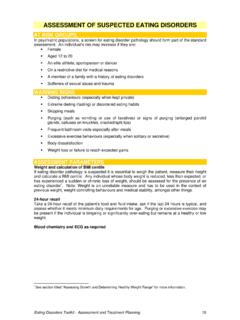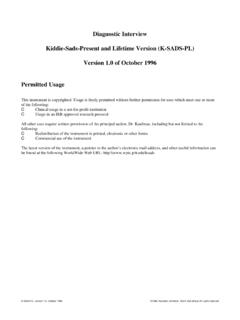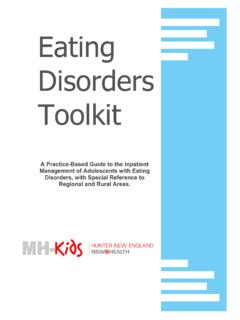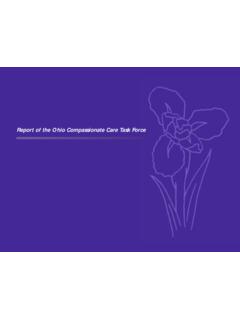Transcription of Enteral Nutrition Policy
1 Policy Directive Royal Prince Alfred Hospital Enteral Nutrition Policy Document No: RPAH_PD2010_035. Functional Sub-Group: Clinical Governance Summary: This Policy aims to ensure that nutritional (+/- hydration). needs are met in patients who are unable to maintain an adequate oral intake for any reason. Approved by: Ken Cahill, Executive Director RPAH. Publication (Issue) Date: May 2010. Next Review Date: May 2014. Replaces Existing Policy : Enteral Nutrition Policy 2003. Previous Review Dates: N/A. Note: Sydney South West Area Health Service (SSWAHS) was established on 1 January 2005 with the amalgamation of the former Central Sydney Area Health Service (CSAHS) and the former South Western Sydney Area Health Service (SWSAHS). In the interim period between 1 January 2005 and the release of single Area-wide SSWAHS. policies (dated after 1 January 2005), the former CSAHS and SWSAHS policies were applicable as follows:- SSWAHS Eastern Zone : CSAHS. SSWAHS Western Zone: SWSAHS.
2 Compliance with this Policy directive is mandatory Page 1 of 9. Sydney South West Area Health Service Policy No: RPAH_PD2010_035. Date Issued: May 2010. Royal Prince Alfred Hospital Enteral Nutrition Policy CONTENTS. 1. Introduc tion .. 3. 2. P olic y S tatement .. 3. 3. P rinc iples / G uidelines .. 3. Referral .. 3. Nursing Responsibilities .. 3. Enteral feeding Flowsheet .. 4. General Guidelines for Starting and Stopping feeding .. 4. Initiating feeding .. 4. Stopping feeding for Procedures or Patient 4. Recommencement of Stopped Feeds .. 5. Ceasing Tube feeding .. 5. Jejunal feeding ..5. Out of Hours Issues .. 5. Storage of Feed Formula and Minimising Contamination .. 5. Hang Time .. 5. Refrigeration Requirements .. 5. Additions to the Feed .. 6. Alternative feeding Regimes .. 6. Giving Medications via the feeding Tube .. 6. Unblocking the feeding Tube .. 6. Managing Complications .. 7. feeding Intolerance .. 7. Vomiting .. 7. Diarrhoea .. 7. Refeeding Syndrome.
3 7. Suspected Aspiration of Feed .. 7. 4 P erformanc e Meas ures .. 8. 5 Definitions .. 8. 6 R eferenc es and links .. 8. 7 Appendix .. 9. Enteral feeding Flowsheet .. 9. Compliance with this Policy directive is mandatory Page 2 of 9. Sydney South West Area Health Service Policy No: RPAH_PD2010_035. Date Issued: May 2010. Royal Prince Alfred Hospital Enteral Nutrition Policy 1. Introduc tion The risks addressed by this Policy : Clinical Risks: Without Nutrition support, patients who are unable to meet their nutritional needs orally will experience deterioration in their nutritional status. Malnutrition is a common problem in hospitals and contributes to increased mortality, morbidity, infectious complications, delayed wound healing, increased length of stay and increased costs. The aims / expected outcome of this Policy To facilitate the safe, appropriate administration of Enteral tube feeding in order to meet patients' nutritional and hydration needs when they are unable to meet their needs orally 2.
4 P olic y S tatement Inappropriate management of tube feeding can have a variety of detrimental effects including: dehydration, malnutrition, impaired swallowing, nasopharyngeal or gastric ulceration, aspiration injuries, and gastrointestinal or respiratory infections. This Policy has been developed to provide a guide to managing Enteral tube feeding in the hospital ward setting. 3. P rinc iples / G uidelines Referral Patients requiring Enteral tube feeding should be referred promptly to the Dietitian for nutritional assessment and prescription of an appropriate individualised Nutrition support regimen. The feeding tube should be inserted according to DOH Policy PD2009_019 Fine Bore Nasogastric feeding Tubes for Adults Policy . The feeding pump is obtained by telephoning the Diet Office (or NARMU if out-of-hours). Nursing Responsibilities Ensure that patient's upper body is raised by at least 30 to minimise aspiration risk. Follow the Enteral feeding Flowsheet (appendix ) to advance the feed rate to the goal rate determined by the Dietitian (recorded in the Enteral feeding Chart).
5 Flush the feeding tube four-hourly with at least 30mL water (or other prescribed amount) to maintain feeding tube patency, as per Enteral feeding Chart. Compliance with this Policy directive is mandatory Page 3 of 9. Sydney South West Area Health Service Policy No: RPAH_PD2010_035. Date Issued: May 2010. Check position of feeding tube once per shift (according to DOH Policy PD2009_019). and inform MO if it appears that tube has been displaced. Assess feeding tolerance each shift: ask patient about abdominal discomfort, overfullness or nausea, perform abdominal assessment if any reported problems: look (observe any signs of abdominal distension); listen (auscultate for presence or absence of bowel sounds); feel (palpate for tenderness, rigidity or tightness). Inform MO if there is increasing tenderness, rigidity or distension, or blood or mucus in stools or a change in bowel sounds. (Note that bowel sounds provide some indication of stomach and colon function only.)
6 Bowel sounds do not need to be present to commence feeding , as the small bowel may still have normal motility and absorptive function.). Chart Enteral feeding and tube flushes, bowel activity, and any signs of feeding intolerance, in the fluid chart, progress notes, and/or nursing care plan. Enteral feeding Flowsheet Enteral feeding Flowsheet see Appendix General Guidelines for Starting and Stopping feeding Initiating feeding Enteral feeding is indicated if the gut is functioning and patient is unable to eat an oral diet (such as where speech pathologist assessment indicates that swallowing is inadequate) or if oral intake is not meeting patient's Nutrition / hydration needs. The position of a fine-bore Enteral feeding tube should be confirmed before feeds commence, according to DOH Policy PD2009_019. feeding may start 4 hours after PEG insertion. The Enteral feeding flowsheet is used for commencing feeds unless MO or Dietitian document alternative instructions.
7 Patients who have been on sliding scale insulin should be changed to a regular sc insulin regimen when they have started Enteral feeds, for better control of BSLs. Stopping feeding for Procedures or Patient Transport Interruption of feeding should be minimised once commenced, as the feeding regimen is designed to provide a precise amount of Nutrition and interruptions will prevent the patient receiving the full amount. For radiology: unless fasting is required, feeds should be continued until patient is ready for transport. For surgical procedures: MOs to document the time that feeds should stop before theatre. In general, six hours should be adequate for surgery, and can often be less. A. fasting period before surgery is not required with jejunal feeding . Caution is required when stopping feeds if the patient is receiving insulin. Perform hourly blood sugar levels initially after stopping feeds. Insulin sliding scale may need to be reviewed if feeds remain off.
8 Compliance with this Policy directive is mandatory Page 4 of 9. Sydney South West Area Health Service Policy No: RPAH_PD2010_035. Date Issued: May 2010. Recommencement of Stopped Feeds If feeds have been stopped for less than 6 hours, they can be recommenced at the previously tolerated rate. If feeds have been stopped for more than 6 hours, use Enteral feeding Flowsheet (appendix ) to start feeding again. After a PEG insertion, follow the endoscopist's instructions to flush the tube and then resume the patient's previous tube feeding regimen. Ceasing Tube feeding Ideally, the tube feeding should not be stopped until the patient is fully established on an oral diet. Contact the Dietitian when the patient is to start eating, so that an appropriate transitional regimen can be arranged. Transitional feeding , that is, combining oral and tube feeding , is the best way to ensure that the patient's full nutritional needs are met while changing from tube feeds to oral diet.
9 This may involve stopping feeds before each main meal, or feeding overnight. Food charts should be kept to allow close monitoring of oral intake, and the dietitian will adjust the feeding regimen accordingly. Jejunal feeding When a patient has a new surgical jejunostomy or nasojejunal feeding tube, advance the feed rate at half the rate in the Flowsheet, ie start at 20mL/h and increase eight- hourly by no more than 20mL/h at a time. Assess feeding tolerance in terms of abdominal exam, as aspirates are not informative in jejunal feeding . Out of Hours Issues Please contact the Diet Office to arrange supply of Enteral feeding pumps or feeding formula. Outside office hours, feeding pumps can be supplied by NARMU. If a patient is receiving a specialised feeding formula and the supply is running low out-of-hours, the feed can be replaced with Osmolite at an interim rate of 60mL/h until the next day when the Diet Office should be informed Storage of Feed Formula and Minimising Contamination Enteral giving sets should be changed every 24 hours.
10 Hang Time Feeds in the closed system bottle can hang (at room temperature) for 24 hours. Feeds remaining in the bottle after 24 hours should be discarded and a new bottle started. Feeds given in a Kangaroo Bag should not hang at room temperature for more than four hours. The bag should be completely empty, and flushed with water, before refilling, and a new bag used every 24 hours. Refrigeration Requirements Unopened feeding formulae may be stored at room temperature, away from direct sunlight. Keep feeding formula in the allocated place on the ward, and return any unused formula to Food Services. Containers of formula made up from a powder (such as Vivonex), or opened formula cans, should be kept covered, refrigerated promptly, and any unused portion discarded after 24 hours. Compliance with this Policy directive is mandatory Page 5 of 9. Sydney South West Area Health Service Policy No: RPAH_PD2010_035. Date Issued: May 2010. Additions to the Feed Occasionally a patient may require extra water, salt etc to be given enterally.









